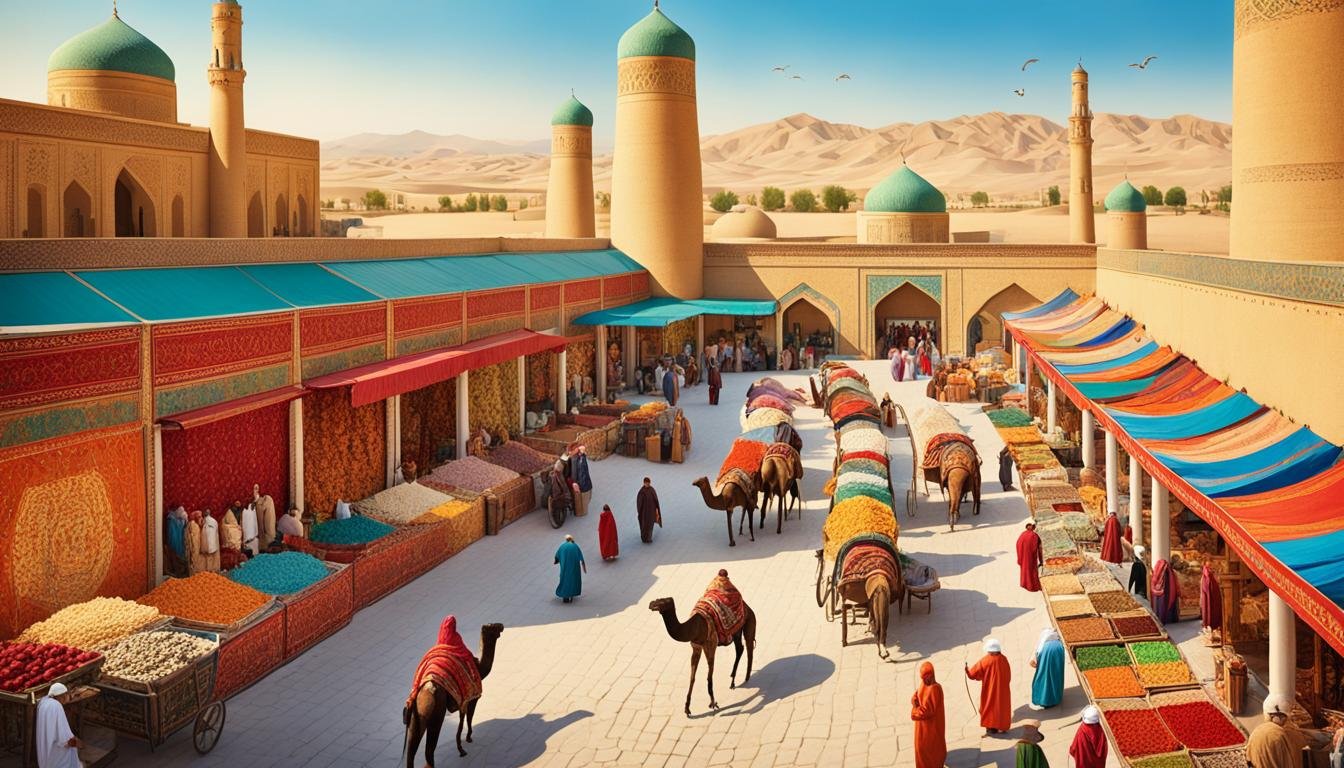Nestled at the crossroads of ancient trade routes, Turkmenistan has long been a hub of cultural exchange and commerce, captivating the world with its rich Silk Road heritage. Remarkably, over 2,500 archaeological sites dot the country’s landscape, each offering a glimpse into the vibrant civilizations that once thrived along the legendary Silk Roads.
Ashgabat, the capital city of Turkmenistan, has emerged as a center for Silk Road studies, drawing scholars and enthusiasts from around the globe. Here, researchers delve into the country’s pivotal role in the intricate network of trade routes that connected the East and West, uncovering the intriguing narratives of Turkmen culture, nomadic civilizations, and the Eurasian crossroads that shaped the course of history.
Key Takeaways
- Turkmenistan’s strategic location at the crossroads of ancient trade routes made it a hub of cultural exchange and commerce for centuries.
- Ashgabat, the capital city, has become a center for Silk Road studies, offering insights into the rich heritage and legacy of this ancient trading network.
- Over 2,500 archaeological sites in Turkmenistan provide a window into the vibrant civilizations that once thrived along the legendary Silk Roads.
- Researchers in Ashgabat are uncovering the intriguing narratives of Turkmen culture, nomadic civilizations, and the Eurasian crossroads that shaped the course of history.
- Turkmenistan’s Silk Road legacy continues to captivate the world, with its strategic location and rich cultural heritage drawing scholars and enthusiasts from around the globe.
Turkmenistan: Cradle of Ancient Civilizations
Turkmenistan has a rich and captivating history, serving as the cradle of several ancient civilizations. One of the most renowned empires to have flourished in this region was the Parthian Empire, which emerged three centuries before the Common Era. The Parthian tribes of skilled horsemen established their capital in the ancient Turkmen city of Nisa, a testament to the region’s strategic importance.
Parthian Empire and Nisa
The Parthian Empire eventually grew to encompass much of Central Asia, rivaling the might of the Roman Empire. Nisa, the Parthian capital, was a thriving metropolis that showcased the region’s cultural and architectural prowess. Excavations of the ancient city have revealed a wealth of artifacts and insights into the Parthian way of life, offering a glimpse into the rich Turkmen culture of the time.
Nomadic Tribes and Carpet Weaving
Alongside the Parthian legacy, Turkmenistan is also renowned for its skilled and fierce nomadic tribes, who have long been celebrated for their intricate and vibrant carpet-weaving traditions. These nomadic peoples, such as the Turkmens, have played a pivotal role in shaping the cultural fabric of the region, with their artistry and craftsmanship serving as a testament to the enduring spirit of the Turkmen people.
Turkmenistan’s rich history as the cradle of ancient civilizations, coupled with the enduring legacies of the Parthian Empire and the skilled nomadic tribes, have cemented the country’s status as a fascinating destination for those interested in exploring the captivating world of the ancient Silk Road.
The Great Silk Road: Connecting Continents
The Silk Road was a vast network of ancient trade routes that connected the East and West, facilitating the exchange of goods, ideas, and cultural influences across the Eurasian continent. Stretching from China to the Mediterranean Sea, this Silk Road played a crucial role in shaping the economies and societies of the regions it traversed. Turkmenistan, situated at the heart of this Silk Road, was a vital crossroads in this intercontinental trading system.
As a Eurasian crossroads, Turkmenistan’s strategic location allowed it to serve as a hub for the movement of goods and the dissemination of knowledge along the Silk Road. Caravans carrying precious commodities such as silk, spices, and textiles would traverse the rugged terrain of Turkmenistan, connecting the ancient civilizations of the East and West. This exchange of goods, ideas, and cultural influences profoundly shaped the development of societies across the Silk Road network.

The Great Silk Road’s significance extended far beyond its economic impact. It facilitated the spread of religions, technologies, and artistic traditions, fostering a rich tapestry of cultural exchange and mutual understanding across the Eurasian landmass. Turkmenistan, with its strategic location at the heart of this vast trading network, played a crucial role in this process, serving as a conduit for the flow of ideas and the cross-pollination of cultures.
Archaeological Wonders of the Silk Road
Turkmenistan’s rich Silk Road heritage is reflected in the remarkable archaeological sites that dot the landscape. Two of the most captivating ancient ruins are Merv and Serakhs, both of which were once thriving hubs along the historic trade routes. These Silk Road archaeology treasures offer a window into the cultural and architectural splendor of the civilizations that flourished in this region.
Ruins of Merv and Serakhs
The ancient city of Merv, a UNESCO World Heritage site, stands as a testament to the grandeur of the Silk Road era. Extensive excavations have unveiled the intricate layouts, towering structures, and artistic flourishes that defined this once-vibrant metropolis. Likewise, the ruins of Serakhs, another important Silk Road settlement, showcase the architectural and cultural heritage of the nomadic tribes and sedentary communities that called this region home.
These ancient ruins embody Turkmenistan’s rich cultural legacy, offering visitors a captivating glimpse into the past. Archaeologists continue to unearth new insights, shedding light on the vibrant societies that thrived along the Silk Road, making these sites invaluable for understanding the history and heritage of the region.
UNESCO’s Efforts to Preserve the Silk Road Legacy
Preserving the rich heritage of the Silk Road has been a key priority for UNESCO, the United Nations Educational, Scientific and Cultural Organization. In partnership with the Government of Turkmenistan, UNESCO has spearheaded various initiatives to safeguard the legacy of this historic trade route that connected continents and civilizations.
International Conference on Silk Road’s Importance
In 2018, UNESCO and the Government of Turkmenistan organized a high-level international conference in Ashgabat to discuss the significance of the Great Silk Road and its potential for fostering intercultural dialogue and international cooperation. The conference brought together experts and representatives from around the world to explore the Silk Road’s multifaceted history, its cultural heritage, and its future prospects.
Expert Meetings and Coordinating Committee
Recognizing the need for a coordinated approach, UNESCO has also convened a series of expert meetings and established a Coordinating Committee to oversee activities related to the World Heritage Serial Nomination of the Silk Roads. These collaborative efforts aim to ensure the sustainable development and preservation of the Silk Road’s legacy, promoting UNESCO’s vision of international cooperation and sustainable development.
Turkmenistan: Silk Road Studies Ashgabat Turkmenistan
Ashgabat, the capital city of Turkmenistan, has emerged as a vibrant hub for Silk Road studies, attracting a diverse array of scholars and researchers from around the world. The city’s strategic location at the heart of the ancient trading network, combined with its rich cultural heritage, have made it an ideal center for academic exploration and the preservation of the Silk Road’s enduring legacy.
Institutions in Ashgabat, such as the Continents States University, are at the forefront of Silk Road studies, conducting cutting-edge research, hosting prestigious international conferences, and collaborating with partners across the globe to further our understanding of this remarkable chapter in world history. Through their efforts, Ashgabat has solidified its position as a leading destination for Turkmenistan, Silk Road Studies, and Cultural Heritage research and exploration.
The city’s Academic Research institutions are not only expanding our knowledge of the Silk Road but also playing a crucial role in preserving its legacy for future generations. By organizing symposia, facilitating international collaborations, and spearheading interdisciplinary projects, these centers of learning are ensuring that the rich history and cultural significance of the Silk Road remain at the forefront of global discourse.
Medieval Islamic Centers on the Silk Road
During the medieval era, the renowned Silk Road was home to a thriving network of Islamic centers that served as hubs of commerce, scholarship, and cultural exchange. Turkmenistan’s city of Merv was one such pivotal stop along this historic trade route, renowned for its role as a center of Islamic learning and a key trading post.
These medieval Islamic centers played a crucial part in the dissemination of knowledge, art, and technology throughout the Silk Road region, contributing immensely to the rich cultural tapestry of the area. They fostered the exchange of ideas, goods, and traditions between diverse civilizations, seamlessly blending elements of Islamic civilization with the Silk Road trade networks and medieval trade.

Merv, in particular, emerged as a renowned center of Islamic scholarship, attracting scholars, intellectuals, and artisans from across the Islamic world. The city’s thriving cultural exchange and vibrant intellectual discourse contributed to the dissemination of ideas, technologies, and artistic traditions along the expansive Silk Road network.
The Oghuz Turkic Tribes and Origins
The modern-day Turkmen people trace their ancestral roots to the Oghuz Turks, a nomadic confederation of tribes that migrated from Mongolia into Central Asia in the 8th century AD. These Oghuz Turks formed the ethnic foundation of the Turkmen population, later adopting Islam and settling in the region of Turkmenistan. The term “Turkmen” was first applied to these Oghuz groups in the 10th century, as they established their identity and presence in the area.
Turkmen Identity and Seljuk Empire
The Turkmen were later incorporated into the expansive Seljuk Empire, which was composed of Oghuz tribes living across present-day Iran and Turkmenistan. The Seljuk Turks, who were of Oghuz descent, rose to power in the 11th century and established a vast empire that stretched from Anatolia to Central Asia. This period marked a significant chapter in the history of the Turkmen, as they became an integral part of the Seljuk’s nomadic civilizations that flourished along the ancient Silk Road trade routes.
Merv: The Glorious Ancient Metropolis
Merv, an ancient city in Turkmenistan, was once a thriving Silk Road metropolis that rivaled the fame of other major Central Asian hubs like Samarkand and Bukhara. According to Zoroastrian literature, Merv possessed the third “horn of plenty” of the ancient world, after Herat and Balkh, indicating its significance as a center of prosperity and abundance.

The city was a vibrant hub of culture, science, and learning, home to renowned poets, philosophers, and scientists such as Omar Khayyam and Ismail Samani. Merv’s ruins, which have been extensively studied by archaeologists, offer a glimpse into the grandeur and historical importance of this ancient Silk Road city. The archaeological findings shed light on the city’s flourishing trade, sophisticated urban planning, and contributions to Central Asian history.
Reviving the Silk Road Spirit
In recent years, there has been a growing effort to revive the legacy of the Silk Road and harness its potential for cultural exchanges and sustainable development. Turkmenistan, with its rich Silk Road heritage, has been at the forefront of these initiatives, dedicated to promoting the shared history and significance of this ancient trade route.
Cultural Exchanges and Sustainable Development
Through events like the 2018 International Conference on the Importance of the Great Silk Road, organized in partnership with UNESCO, Turkmenistan has sought to foster intercultural dialogue and international cooperation. These efforts aim to ensure that the Silk Road’s history and cultural connections continue to inspire and inform contemporary efforts towards sustainable development in the region.
By reviving the Silk Road spirit, Turkmenistan is not only preserving its cultural heritage but also exploring new avenues for Silk Road Revival, Cultural Exchanges, Sustainable Development, and International Cooperation. As a strategic crossroads, the country is well-positioned to facilitate these vital exchanges and foster shared prosperity along the ancient trade routes.
Turkmenistan’s Strategic Crossroads Location
Turkmenistan’s strategic position at the heart of the historic Silk Road has long made it a crucial crossroads for trade, cultural exchange, and geopolitical influence in the Eurasian region. Bordered by Kazakhstan, Uzbekistan, Afghanistan, and Iran, as well as the Caspian Sea, Turkmenistan has served as a vital corridor connecting the East and West, facilitating the movement of goods, ideas, and people across the continent.
This central location in Central Asia has contributed to Turkmenistan’s rich cultural heritage, as the country has been a melting pot of diverse civilizations and nomadic tribes throughout history. Turkmenistan’s strategic crossroads position has also made it an important player in contemporary efforts to revive the Silk Road spirit and promote sustainable development in the region.

Turkmenistan’s unique geopolitical standing as a Silk Road hub has attracted significant international attention and investment. The country’s vast energy resources, including significant reserves of natural gas, have further strengthened its position as a key player in Eurasian connectivity and energy security.
As the global economy and geopolitical landscape continue to evolve, Turkmenistan’s strategic location at the intersection of major trade routes and cultural influences is poised to play an increasingly important role in shaping the future of the Eurasian region.
Conclusion
Turkmenistan’s deep-rooted connection to the Silk Road has shaped its history, culture, and identity in profound ways. From the ancient Parthian Empire and nomadic tribes to the medieval Islamic centers and the modern-day efforts to preserve and revive the Silk Road’s legacy, Turkmenistan has played a pivotal role in this remarkable chapter of world history. As a strategic crossroads and a hub of cultural exchange, the country continues to be at the forefront of initiatives to study, preserve, and celebrate the Silk Road’s enduring significance.
Through international cooperation, academic research, and a commitment to sustainable development, Turkmenistan is ensuring that the spirit of the Silk Road lives on, connecting continents and fostering intercultural dialogue for generations to come. The country’s rich cultural heritage, embodied in its architectural wonders, nomadic traditions, and flourishing arts, serves as a testament to the enduring legacy of the Silk Road.
As Turkmenistan continues to explore and preserve its Silk Road legacy, it remains a beacon of the region’s cultural diversity and a prime destination for those seeking to immerse themselves in the captivating history and vibrant traditions that have shaped this remarkable land.
Source Links
- Turkmenistan – https://silkroadresearch.blog/turkmenistan/
- Turkmenistan | Silk Roads Programme – https://en.unesco.org/silkroad/countries-alongside-silk-road-routes/turkmenistan
- International Conference on the “Importance of the Great Silk Road: Present and Future Development” – https://en.unesco.org/silkroad/content/international-conference-importance-great-silk-road-present-and-future-development


